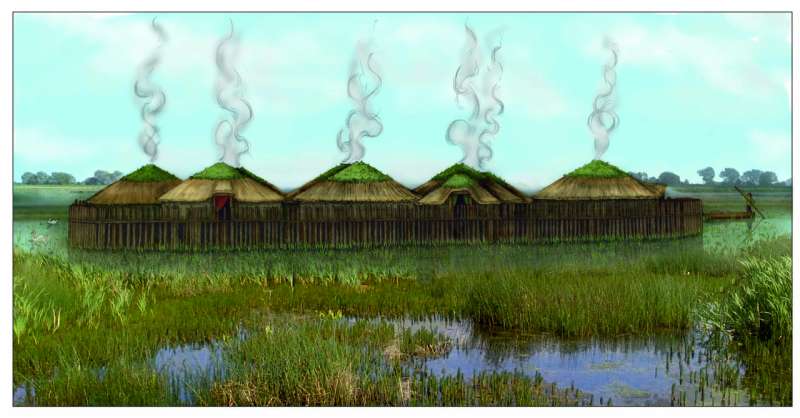Prehistoric Stilt-House Dwellers in England's Ancient Marshland Show Signs of 'Cozy Domesticity'

March 19, 2024
This article underwent extensive review per Science X's editorial standards and guidelines. The editing team ensured the content's credibility through the following measures:
- fact-checked
- trusted source
- proofread
by University of Cambridge
A new comprehensive report uncovers the daily lives of England's prehistoric fenlanders by examining the charred remains of a stilt village dating back nearly 3,000 years.
The report studies Must Farm, a late Bronze Age hamlet dating back to around 850BC. Archeologists from the University of Cambridge discovered four large wooden roundhouses and a squared entrance structure, all constructed on stilts above a leisurely moving river.
The hamlet, elevated two meters above the riverbed and surrounded by a two-meter-high fence of pointed posts, had walkways connecting the primary dwellings. The ensemble lasted less than a year before a massive fire caused its destruction. The buildings and belongings within them fell into the river below, with the combination of charring and waterlogging ensuring remarkable preservation. Consequently, it's been dubbed 'Britain's Pompeii.'
Years of examining thousands of artifacts from the Must Farm have revealed that its residents led comfortable lives that bore striking resemblance to our modern lifestyles, including homes with contemporary layouts, meals, and clothes, and even recycling.
The water-bound village also held a collection of long spear shafts, a Denmark- and Iran-sourced bead necklace, and a human skull eroded smooth via touch, possibly a treasured keepsake.
According to the Cambridge archeologists, the site offers an unparalleled insight into the circular architecture, household interiors, and overall domestic lifestyle of the swamp fenlanders of East Anglia some eight centuries before the Romans arrived.
Detailed findings from Must Farm, excavated by Cambridge's Archaeological Unit (CAU) in 2015-16 following its discovery near Peterborough, are detailed in two reports published by the McDonald Institute for Archaeological Research at Cambridge.
Mark Knight, co-author of the report and lead excavator, hailed the stilt village's residents as 'skilled and confident home builders who developed a design ideal for their increasingly water-logged environment.'
He reminisced about the uncanny feeling of the site's Bronze Age inhabitants having just departed. The ghosts of their world - metallic tools hanging from walls to the smell of recently brewed porridge - were almost tangible.
Five structures, walkways, and fencing were unearthed on-site. However, the original settlement is believed to have been twice the size, with half removed by quarrying in the twentieth century. It could have housed around sixty people in family units.
The underlying river, teeming with vegetation and slow-moving, cushioned the fire-ravaged remains, providing researchers with a mirror image of the former layout.
One of the primary roundhouses boasted almost fifty square meters of floor space, segmented into activity zones akin to contemporary living spaces.
Drawing a parallel with estate agent tours, David Gibson, report co-author and CAU's Archaeological Manager, described the research process at Must Farm.
Structure One's northeast quadrant - the site's kitchen - housed ceramic and wooden containers of various sizes. Some pots were even stacked within each other to save space.
Metal tools were found along the building's eastern side, while the vacant northwest might have served as a sleeping area. The southeast corner contained fabric scraps, bobbins, and loom weights, suggesting it was a light-flooded entrance conducive to textile work.
The roundhouse's southwest corner served as an indoor sheep-holding area. While no human fatalities were detected in the fire, several lambs were burnt alive.
The skeletons showed lambs between three to six months old, which suggests the fire occurred in late summer or early fall. The green wooden architecture further confirms that the site was constructed barely a year before the disaster.
The metalwork tool kits contained in all the roundhouses were surprisingly uniform, including sickles, axes, curved gouges for woodworking, and handheld razors for hair cutting. Each roundhouse also contained items for textile production, such as spindle whorls and thread bobbins, although spinning seemed to be conducted in three of the roundhouses and only in Structure One were these yarns transformed into fabrics.
The textiles found have been deemed the finest of their era in Europe, featuring details such as pile tufts and tubular selvedge to create a soft, almost velvet-like texture, and neater seams and hems. Each roundhouse roof was constructed in three layers: insulating straw, turf, and clay, which made the houses warm, waterproof, and well-ventilated, according to project archaeologist Dr. Chris Wakefield.
There was also a separate smaller square building, Structure Four, which might have served as the settlement's entrance. A large wooden bucket that contained several worn or damaged bronze objects and axe heads was stored there, perhaps for later smelting and recycling into new tools.
Rubbish dumps, known as middens, were placed around each roundhouse. They were comprised of waste such as broken pots and butchered animal bone, as well as fossilized feces known as coprolites. Some coprolites also contained parasite eggs, suggesting problems with intestinal worms among the inhabitants.
An intact hafted axe was found in the silt directly underneath Structure One, potentially left as a good luck token or spiritual offering upon the building's completion. Several artifacts still contained remnants of daily life, despite being millennia old, such as a pottery bowl with fingerprints still visible in the clay. It contained what was presumably its final meal; a wheat porridge mixed with animal fats. A wooden spatula used to stir the mixture was also recovered, still resting against the bowl's interior.
The inhabitants seemed to enjoy distinct cuts of meat, particularly the forelegs of boar, and they preferred seafood such as pike and bream. The existence of several small dog skulls suggests the presence of domesticated dogs, used for hunting and fed on scraps.
The Must Farm residents dependent on the local woodlands, from which they gathered resources within a two-mile radius. They hunted boar and deer, grazed sheep, and harvested wheat, flax, and wood. Waterways were crucial for transportation, and nine log boats dating back to the Bronze and Iron Ages were discovered upstream.
Although most of the recovered items were everyday objects, there were some significant finds. A necklace of beads made from a variety of materials was lost in a fire. Many decorative beads and almost all of Must Farm's 49 glass beads originate from other parts of Europe and the Middle East.
The site also bears traces of possible violence from the Bronze Age, but its location may have been chosen primarily for resource availability. Spears and swords found on the site were likely used for hunting rather than combat.
Only a few human remains were recovered, including a polished skull of an adult woman. The polishing is likely from repeated touching, suggesting it may have been a keepsake of affection rather than a warrior's trophy.
'The cause of the fire that tore through the settlement will probably never be known,' said CAU's David Gibson. 'Some argue it may have come under attack, as the occupants never returned for their goods, which would have been fairly easy to retrieve from the shallow waters.'
However, others think it more likely to have been an accident. If an internal fire took hold in one of the roundhouses, it would spread between the tightknit structures within minutes.
Added Gibson, 'A settlement like this would have had a shelf-life of maybe a generation, and the people who built it had clearly constructed similar sites before. It may be that after the fire, they simply started again.'
'There is every possibility that the remains of many more of these stilted settlements are buried across Fenland, waiting for us to find them.'
Provided by University of Cambridge




